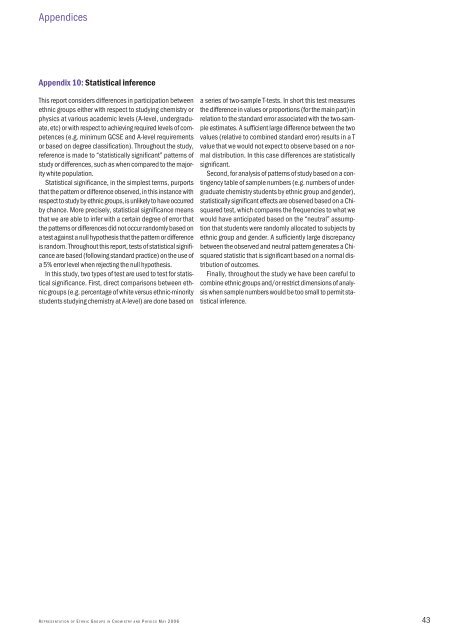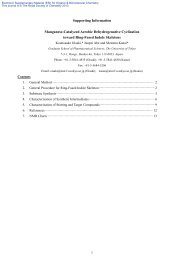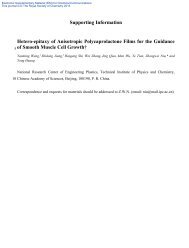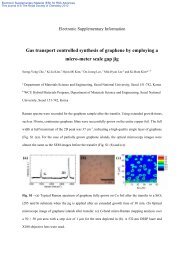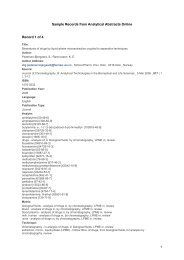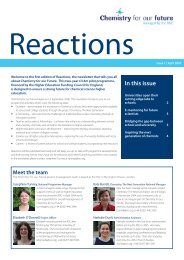Representation of Ethnic Groups in Chemistry and Physics
Representation of Ethnic Groups in Chemistry and Physics
Representation of Ethnic Groups in Chemistry and Physics
Create successful ePaper yourself
Turn your PDF publications into a flip-book with our unique Google optimized e-Paper software.
Appendices<br />
Appendix 10: Statistical <strong>in</strong>ference<br />
This report considers differences <strong>in</strong> participation between<br />
ethnic groups either with respect to study<strong>in</strong>g chemistry or<br />
physics at various academic levels (A-level, undergraduate,<br />
etc) or with respect to achiev<strong>in</strong>g required levels <strong>of</strong> competences<br />
(e.g. m<strong>in</strong>imum GCSE <strong>and</strong> A-level requirements<br />
or based on degree classification). Throughout the study,<br />
reference is made to “statistically significant” patterns <strong>of</strong><br />
study or differences, such as when compared to the majority<br />
white population.<br />
Statistical significance, <strong>in</strong> the simplest terms, purports<br />
that the pattern or difference observed, <strong>in</strong> this <strong>in</strong>stance with<br />
respect to study by ethnic groups, is unlikely to have occurred<br />
by chance. More precisely, statistical significance means<br />
that we are able to <strong>in</strong>fer with a certa<strong>in</strong> degree <strong>of</strong> error that<br />
the patterns or differences did not occur r<strong>and</strong>omly based on<br />
a test aga<strong>in</strong>st a null hypothesis that the pattern or difference<br />
is r<strong>and</strong>om. Throughout this report, tests <strong>of</strong> statistical significance<br />
are based (follow<strong>in</strong>g st<strong>and</strong>ard practice) on the use <strong>of</strong><br />
a 5% error level when reject<strong>in</strong>g the null hypothesis.<br />
In this study, two types <strong>of</strong> test are used to test for statistical<br />
significance. First, direct comparisons between ethnic<br />
groups (e.g. percentage <strong>of</strong> white versus ethnic-m<strong>in</strong>ority<br />
students study<strong>in</strong>g chemistry at A-level) are done based on<br />
a series <strong>of</strong> two-sample T-tests. In short this test measures<br />
the difference <strong>in</strong> values or proportions (for the ma<strong>in</strong> part) <strong>in</strong><br />
relation to the st<strong>and</strong>ard error associated with the two-sample<br />
estimates. A sufficient large difference between the two<br />
values (relative to comb<strong>in</strong>ed st<strong>and</strong>ard error) results <strong>in</strong> a T<br />
value that we would not expect to observe based on a normal<br />
distribution. In this case differences are statistically<br />
significant.<br />
Second, for analysis <strong>of</strong> patterns <strong>of</strong> study based on a cont<strong>in</strong>gency<br />
table <strong>of</strong> sample numbers (e.g. numbers <strong>of</strong> undergraduate<br />
chemistry students by ethnic group <strong>and</strong> gender),<br />
statistically significant effects are observed based on a Chisquared<br />
test, which compares the frequencies to what we<br />
would have anticipated based on the “neutral” assumption<br />
that students were r<strong>and</strong>omly allocated to subjects by<br />
ethnic group <strong>and</strong> gender. A sufficiently large discrepancy<br />
between the observed <strong>and</strong> neutral pattern generates a Chisquared<br />
statistic that is significant based on a normal distribution<br />
<strong>of</strong> outcomes.<br />
F<strong>in</strong>ally, throughout the study we have been careful to<br />
comb<strong>in</strong>e ethnic groups <strong>and</strong>/or restrict dimensions <strong>of</strong> analysis<br />
when sample numbers would be too small to permit statistical<br />
<strong>in</strong>ference.<br />
R EPRESENTATION OF E THNIC G ROUPS IN C HEMISTRY AND P HYSICS M AY 2006<br />
43


